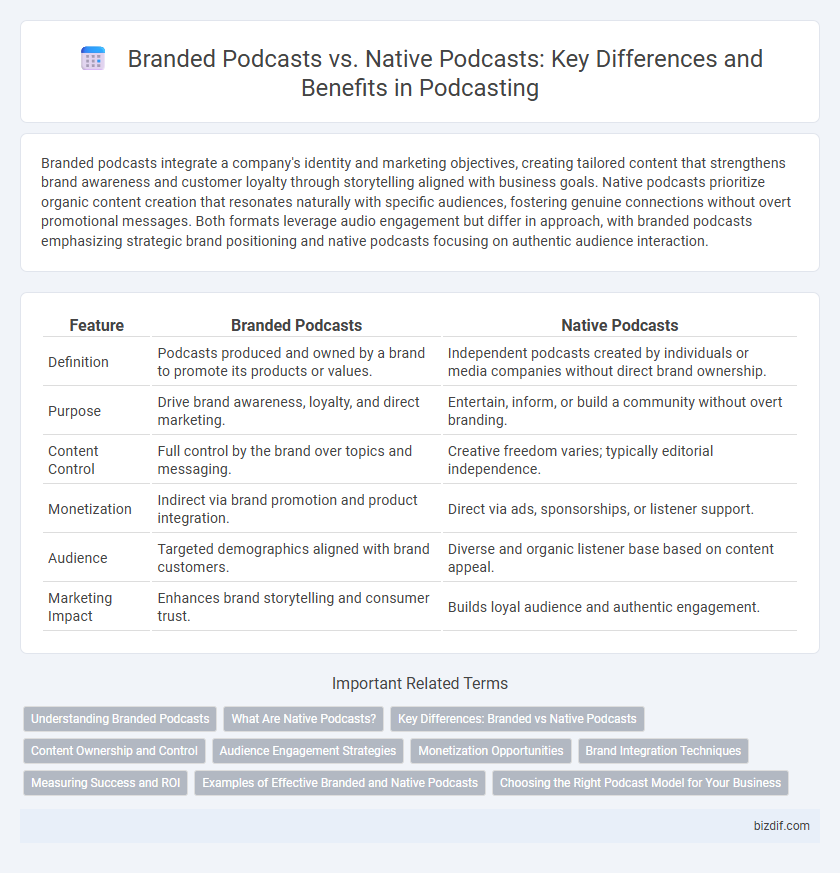Branded podcasts integrate a company's identity and marketing objectives, creating tailored content that strengthens brand awareness and customer loyalty through storytelling aligned with business goals. Native podcasts prioritize organic content creation that resonates naturally with specific audiences, fostering genuine connections without overt promotional messages. Both formats leverage audio engagement but differ in approach, with branded podcasts emphasizing strategic brand positioning and native podcasts focusing on authentic audience interaction.
Table of Comparison
| Feature | Branded Podcasts | Native Podcasts |
|---|---|---|
| Definition | Podcasts produced and owned by a brand to promote its products or values. | Independent podcasts created by individuals or media companies without direct brand ownership. |
| Purpose | Drive brand awareness, loyalty, and direct marketing. | Entertain, inform, or build a community without overt branding. |
| Content Control | Full control by the brand over topics and messaging. | Creative freedom varies; typically editorial independence. |
| Monetization | Indirect via brand promotion and product integration. | Direct via ads, sponsorships, or listener support. |
| Audience | Targeted demographics aligned with brand customers. | Diverse and organic listener base based on content appeal. |
| Marketing Impact | Enhances brand storytelling and consumer trust. | Builds loyal audience and authentic engagement. |
Understanding Branded Podcasts
Branded podcasts are audio series created by companies to promote their products or values while engaging their target audience through storytelling and relevant content. These podcasts seamlessly integrate brand messaging with informative or entertaining material, enhancing brand awareness and loyalty without overt advertising. Understanding branded podcasts involves recognizing their strategic role in content marketing to build lasting customer relationships and drive business goals.
What Are Native Podcasts?
Native podcasts are audio series created by independent producers or media companies designed to engage niche audiences with authentic storytelling and specialized content. Unlike branded podcasts, which are produced by companies to promote products or services, native podcasts prioritize content quality and listener experience over marketing goals. These podcasts often build loyal communities by delivering valuable, relevant, and consistent programming tailored to specific interests.
Key Differences: Branded vs Native Podcasts
Branded podcasts are produced by companies to promote their products or services, featuring content aligned with their marketing goals and brand identity. Native podcasts originate from independent creators or media outlets, focused on storytelling or niche subjects without direct commercial intent. Key differences lie in content purpose, audience engagement strategies, and the degree of commercial influence embedded in each podcast type.
Content Ownership and Control
Branded podcasts offer companies full content ownership and control, enabling tailored messaging aligned with their marketing strategies and direct audience engagement. Native podcasts, created by third parties or existing podcast brands, often limit the brand's control over content, distribution, and audience data. Securing content ownership in branded podcasts ensures intellectual property rights and long-term use flexibility, critical for brand consistency and strategic communication.
Audience Engagement Strategies
Branded podcasts leverage a company's existing brand identity to create targeted content that resonates with their loyal customer base, enhancing audience engagement through consistent messaging and promotional integration. Native podcasts prioritize authentic storytelling and organic content that naturally aligns with the listener's interests, fostering deeper emotional connections and long-term listener retention. Effective audience engagement strategies include interactive elements such as listener Q&A, episode-exclusive offers, and cross-platform community building tailored to each podcast type's unique strengths.
Monetization Opportunities
Branded podcasts generate revenue through sponsorship deals, product placements, and direct promotion of a company's offerings, leveraging brand loyalty to attract targeted advertising. Native podcasts monetize by integrating seamless storytelling and content that appeals to niche audiences, often using subscription models, premium content access, and listener-supported funding such as crowdfunding or memberships. Both formats exploit unique monetization strategies tailored to their audience engagement, with branded podcasts emphasizing brand-driven advertising while native podcasts rely heavily on community and content value.
Brand Integration Techniques
Branded podcasts use overt brand messaging and sponsor mentions to directly promote products, enhancing listener recall through explicit integration. Native podcasts embed brand stories and values seamlessly within engaging content, fostering authentic emotional connections without disrupting the narrative flow. Effective brand integration techniques combine storytelling with subtle product placement, maintaining audience trust while driving brand awareness.
Measuring Success and ROI
Measuring success in branded podcasts involves tracking listener engagement, brand awareness uplift, and conversion rates tied directly to marketing goals, while native podcasts prioritize audience growth, content relevance, and subscription metrics as core performance indicators. ROI for branded podcasts is often calculated through attribution models linking podcast exposure to sales or lead generation, contrasting with native podcasts which focus more on long-term value through advertising revenue and listener retention. Effective analytics tools and clear KPIs tailored to either branded or native strategies ensure precise measurement and optimized return on investment in podcasting initiatives.
Examples of Effective Branded and Native Podcasts
Branded podcasts such as GE's "The Message" and Michelin's "To Food and Beyond" successfully integrate marketing with storytelling, enhancing brand loyalty through immersive narratives. Native podcasts like "Serial" and "The Daily" excel by focusing on compelling, journalistic content that attracts large, engaged audiences without overt advertising. Both formats leverage high production quality and targeted content to establish strong listener bases and achieve distinct strategic goals in the podcasting landscape.
Choosing the Right Podcast Model for Your Business
Choosing the right podcast model for your business involves assessing the goals of brand visibility versus content authenticity. Branded podcasts leverage company narratives and promotional messages to enhance brand awareness, while native podcasts prioritize organic storytelling and audience engagement without direct commercial intent. Analyzing target demographics, marketing objectives, and budget constraints ensures alignment with either a branded or native podcast strategy, maximizing listener retention and business impact.
Branded Podcasts vs Native Podcasts Infographic

 bizdif.com
bizdif.com